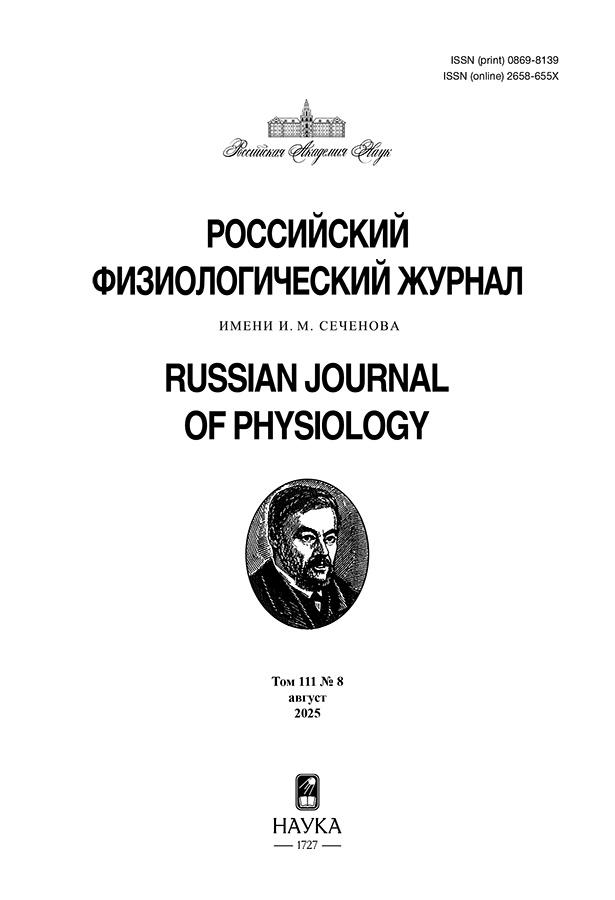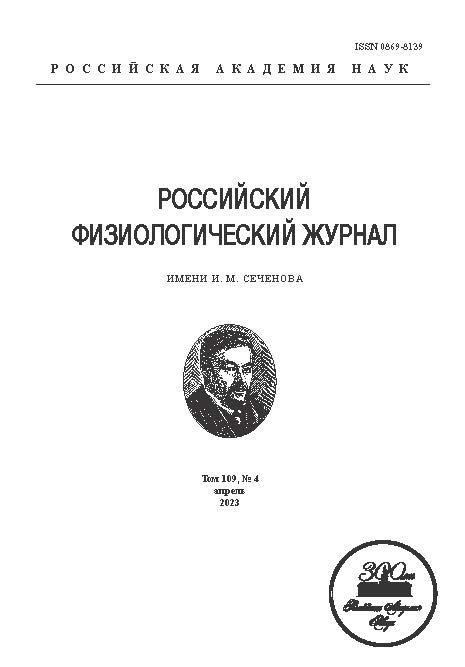Особенности изменения скоростных показателей мозгового кровотока крыс на разных этапах старения
- Авторы: Горшкова О.П.1
-
Учреждения:
- Институт физиологии им. И.П. Павлова РАН
- Выпуск: Том 109, № 4 (2023)
- Страницы: 457-465
- Раздел: ЭКСПЕРИМЕНТАЛЬНЫЕ СТАТЬИ
- URL: https://rjmseer.com/0869-8139/article/view/651576
- DOI: https://doi.org/10.31857/S0869813923040052
- EDN: https://elibrary.ru/VJAVLQ
- ID: 651576
Цитировать
Полный текст
Аннотация
Изменение скорости мозгового кровотока может вносить значительный вклад в формирование возрастных цереброваскулярных заболеваний. В работе изучалось изменение скоростных показателей церебрального кровотока у крыс на разных этапах старения. Проводился сравнительный анализ состояния кровотока коры и подкорковых структур полушарий головного мозга по величине линейных скоростей, измеренных методом ультразвуковой допплерографии, и индексов кровотока у молодых крыс линии Sprague-Dawley в возрасте 4-х мес. и стареющих крыс в возрасте 18-ти и 23-х мес. Установлено, что старение сопровождается изменениями параметров мозгового кровотока в коре и подкорковых структурах головного мозга крыс, которые развиваются постепенно и отличаются на разных этапах старения. К 18 месяцам увеличивается перфузия в лобной и теменной области полушарий головного мозга за счет повышения пиковых и средней за сердечный цикл скоростей кровотока и снижения уровня сопротивления мозговых сосудов. Эти процессы предшествуют развитию последующих гипоперфузионных нарушений кровотока, наблюдаемых на более поздних этапах старения. Гипоперфузионные изменения у 23-месячных крыс наиболее выражены в лобной области полушарий головного мозга и характеризуются снижением пиковых скоростей и увеличением показателей индексов кровотока.
Ключевые слова
Об авторах
О. П. Горшкова
Институт физиологии им. И.П. Павлова РАН
Автор, ответственный за переписку.
Email: o_gorshkova@inbox.ru
Россия, Санкт-Петербург
Список литературы
- Iadecola C (2013) The pathobiology of vascular dementia. Neuron 80(4): 844–866. https://doi.org/10.1016/j.neuron.2013.10.008
- De Silva TM, Faraci FM (2016) Microvascular dysfunction and cognitive impairment. Cell Mol Neurobiol 36: 241–258. https://doi.org/10.1007/s10571-015-0308-1
- Wang N, Allali G, Kesavadas C, Noone ML, Pradeep VG, Blumen HM, Verghese J (2015) Cerebral small vessel disease and motoric cognitive risk syndrome: results from the Kerala-Einstein Study. J Alzheimers Dis 50: 699–707. https://doi.org/10.3233/JAD-150523
- Fulop GA, Tarantini S, Yabluchanskiy A, Molnar A, Prodan CI, Kiss T, Csipo T, Lipecz A, Balasubramanian P, Farkas E, Toth P, Sorond F, Csiszar A, Ungvari Z (2019) Role of age-related alterations of the cerebral venous circulation in the pathogenesis of vascular cognitive impairment. Am J Physiol Heart Circ Physiol 316(5): H1124–H1140. https://doi.org/10.1152/ajpheart.00776.2018
- Diaz-Otero JM, Garver H, Fink GD, Jackson WF, Dorrance AM (2016) Aging is associated with changes to the biomechanical properties of the posterior cerebral artery and parenchymal arterioles. Am J Physiol Heart Circ Physiol 310(3): H365–H375. https://doi.org/10.1152/ajpheart.00562.2015
- Kalaria RN (2012) Cerebrovascular disease and mechanisms of cognitive impairment: evidence from clinicopathological studies in humans. Stroke 43(9): 2526–2534. https://doi.org/10.1161/STROKEAHA.112.655803
- Staffaroni AM, Cobigo Y, Elahi FM, Casaletto KB, Walters SM, Wolf A, Lindbergh CA, Rosen HJ, Kramer JH (2019) A longitudinal characterization of perfusion in the aging brain and associations with cognition and neural structure. Hum Brain Mapp 40(12): 3522–3533. https://doi.org/10.1002/hbm.24613
- Toth P, Tarantini S, Csiszar A, Ungvari Z (2017) Functional vascular contributions to cognitive impairment and dementia: mechanisms and consequences of cerebral autoregulatory dysfunction, endothelial impairment, and neurovascular uncoupling in aging. Am J Physiol Heart Circ Physiol 312(1): H1–H20. https://doi.org/10.1152/ajpheart.00581.2016
- Hshieh TT, Dai W, Cavallari M, Guttmann CR, Meier DS, Schmitt EM, Dickerson BC, Press DZ, Marcantonio ER, Jones RN, Gou YR, Travison TG, Fong TG, Ngo L, Inouye SK, Alsop DC, SAGES Study Group (2017) Cerebral blood flow MRI in the nondemented elderly is not predictive of post-operative delirium but is correlated with cognitive performance. J Cereb Blood Flow Metab 37(4): 1386–1397. https://doi.org/10.1177/0271678X16656014
- Aanerud J, Borghammer P, Chakravarty MM, Vang K, Rodell AB, Jónsdottir KY, Møller A, Ashkanian M, Vafaee MS, Iversen P, Johannsen P, Gjedde A (2012) Brain energy metabolism and blood flow differences in healthy aging. J Cereb Blood Flow Metab 32(7): 1177–1187. https://doi.org/10.1038/jcbfm.2012.18
- Nemati M, Bavil AS, Taheri N (2009) Comparison of normal values of Duplex indices of vertebral arteries in young and elderly adults. Cardiovasc Ultrasound 7: 2. https://doi.org/10.1186/1476-7120-7-2
- Zhang N, Gordon ML, Goldberg TE (2017) Cerebral blood flow measured by arterial spin labeling MRI at resting state in normal aging and Alzheimer’s disease. Neurosci Biobehav Rev 72: 168–175. https://doi.org/10.1016/j.neubiorev.2016.11.023
- Claassen JAHR, Thijssen DHJ, Panerai RB, Faraci FM (2021) Regulation of cerebral blood flow in humans: physiology and clinical implications of autoregulation. Physiol Rev 101(4): 1487–1559. https://doi.org/1010.1152/physrev.00022.2020
- Филатова ОВ, Сидоренко АА (2015) Возрастные и половые особенности гемодинамических характеристик артерий головного мозга. Acta Biol Sibirica 3–4. [Filatova OV, Sidorenko AA (2015) Age and sex characteristics of hemodynamic characteristics of cerebral arteries. Acta Biol Sibirica 3–4. (In Russ)].
- Alwatban MR, Aaron SE, Kaufman CS, Barnes JN, Brassard P, Ward JL, Miller KB, Howery AJ, Labrecque L, Billinger SA (2021) Effects of age and sex on middle cerebral artery blood velocity and flow pulsatility index across the adult lifespan. J Appl Physiol 130(6): 1675–1683. https://doi.org/10.1152/japplphysiol.00926.2020
- Gorshkova OP (2022) Age-related changes in the indices of cerebral blood flow velocity in rats. J Evol Biochem Phys 58(3): 894–900. https://doi.org/10.1134/S0022093022030231
- Chen JJ, Rosas HD, Salat DH (2013) The relationship between cortical blood flow and sub-cortical white-matter health across the adult age span. PLoS One 8(2): e56733. https://doi.org/10.1371/journal.pone.0056733
- Mander BA, Rao V, Lu B, Saletin JM, Lindquist JR, Ancoli-Israel S, Jagust W, Walker MP (2014) Prefrontal atrophy, disrupted NREM slow waves and impaired hippocampal-dependent memory in aging. Nat Neurosci 16: 357–364. https://doi.org/10.1038/nn.3324
- Oh H, Madison C, Villeneuve S, Markley C, Jagust WJ (2014) Association of gray matter atrophy with age, β-amyloid, and cognition in aging. Cereb Cortex 24: 1609–1618. https://doi.org/10.1093/cercor/bht017
- Heyer EJ, Mergeche JL, Connolly ES Jr (2014) Middle cerebral artery pulsatility index and cognitive improvement after carotid endarterectomy for symptomatic stenosis. J Neurosurg 120(1): 126–131. https://doi.org/10.3171/2013.8.JNS13931
- Albina G, Fernandez Cisneros L, Laiño R, Nobo UL, Ortega D, Schwarz E, Barja L, Lagos R, Giniger A, Ameriso SF (2004) Trancranial Doppler monitoring during head upring tilt table testing in patient with suspected neurocardiogenie syncope. Europace 6(1): 63–69. https://doi.org/10.1016/j.eupc.2003.09.009
- Guan J, Zhang S, Zhou Q, Li C, Lu Z (2013) Usefulness of transcranial Doppler ultrasound in evaluating cervical-cranial collateral circulations. Interv Neurol 2(1): 8–18. https://doi.org/10.1159/000354732
- Faber JE, Zhang H, Lassance-Soares RM, Prabhakar P, Najafi AH, Burnett MS, Epstein SE (2011) Aging causes collateral rarefaction and increased severity of ischemic injury in multiple tissues. Arterioscler Thromb Vasc Biol 31(8): 1748–1756. https://doi.org/10.1161/ATVBAHA.111.227314
- Sharma VK, Tsivgoulis G, Lao AY, Malkoff MD, Alexandrov AV (2007) Noninvasive detection of diffuse intracranial disease. Stroke 38(12): 3175–3181. https://doi.org/10.1161/STROKEAHA.107.490755
- Vagli C, Fisicaro F, Vinciguerra L, Puglisi V, Rodolico MS, Giordano A, Ferri R, Lanza G, Bella R (2020) Cerebral Hemodynamic Changes to Transcranial Doppler in Asymptomatic Patients with Fabry’s Disease. Brain Sci 10(8): 546. https://doi.org/10.3390/brainsci10080546
- Wierenga CE, Hays CC, Zlatar ZZ (2014) Cerebral blood flow measured by arterial spin labeling MRI as a preclinical marker of Alzheimer’s disease. J Alzheimers Dis 42: S411–S419. https://doi.org/10.3233/JAD-141467
- Ghaffari M, Alaraj A, Du X, Zhou XJ, Charbel FT, Linninger AA (2018) Quantification of near-wall hemodynamic risk factors in large-scale cerebral arterial trees. Int J Numer Method Biomed Eng 34(7): e2987. https://doi.org/10.1002/cnm.2987
- O’Rourke MF, Safar ME (2005) Relationship between aortic stiffening and microvascular disease in brain and kidney: cause and logic of therapy. Hypertension 46: 200–204. https://doi.org/10.1161/01.HYP.0000168052.00426.65
- Moore SM, Zhang H, Maeda N, Doerschuk CM, Faber JE (2015) Cardiovascular risk factors cause premature rarefaction of the collateral circulation and greater ischemic tissue injury. Angiogenesis 18(3): 265–281. https://doi.org/10.1007/s10456-015-9465-6.0.1007/s10456-015-9465-6
- Young AP, Zhu J, Bagher AM, Denovan-Wright EM, Howlett SE, Kelly MEM (2021) Endothelin B receptor dysfunction mediates elevated myogenic tone in cerebral arteries from aged male Fischer 344 rats. Geroscience 43(3): 1447–1463. https://doi.org/10.1007/s11357-020-00309-7














